#flutter ui kit
Text
#Flutter UI design tutorial#Flutter app UI design#app#app ui design#design#design app#design app in flutter#design kit#dev#developer#developerhub#devhub#devhubspot#flutter#flutter app#flutter tutorial#flutter ui#flutter ui design#flutter ui kit#ios#kit#real estate#real estate app development#real estate app flutter#real estate app ui design in flutter#real state#real state app ui#template#tutorial#ui
0 notes
Text
#Flutter UI design tutorial#Flutter app UI design#app#app ui design#design#design app#design app in flutter#design kit#dev#developer#developerhub#devhub#devhubspot#flutter#flutter app#flutter tutorial#flutter ui#flutter ui design#flutter ui kit#ios#kit#real estate#real estate app development#real estate app flutter#real estate app ui design in flutter#real state#real state app ui#template#tutorial#ui
0 notes
Text
Flutter UI Kit

A Flutter UI Kit is a pre-built collection of user interface components, templates, and design elements that can be used to accelerate the development of Flutter applications. It provides a set of ready-to-use UI components, such as buttons, cards, forms, and navigation patterns, making it easier to create consistent and visually appealing user interfaces in Flutter. For more details, visit https://www.getwidget.dev
0 notes
Text
Biggest Pro Widget Flutter Kits v1.0 - Best Selling Flutter Widget Kit 3.0 Flutter UI Kit
Are you looking for a way to streamline your mobile app development process and create beautiful, responsive user interfaces? Look no further than the Biggest Pro Widget Flutter Kits v1.0 – Best Selling Flutter Widget Kit 3.0 Flutter UI Kit.
This comprehensive widget library is designed to help developers create stunning user interfaces for their mobile apps with ease. With over 200 widgets and…

View On WordPress
#Best Selling Flutter Widget Kit#Biggest Pro Widget Flutter Kits#Flutter app design#Flutter components#Flutter development#Flutter UI Kit#Mobile app design#Mobile app development#UI/UX design#Widget libraries
0 notes
Text
Flutter, Google's UI toolkit, is a game-changer for startups. It allows developers to create high-quality mobile apps for iOS and Android simultaneously, saving time and resources. With its hot reload feature, developers can see changes instantly, speeding up the development process. Flutter's rich set of pre-built widgets and customizable designs make it easier to create visually appealing apps, helping startups stand out in a crowded market.
1 note
·
View note
Text
0 notes
Text
FlutKit v10.1 – Flutter UI Kit App Source
FlutKit v10.1 – Flutter UI Kit App Source
FlutKit Flutter UI Kit App Source
FlutKit v10.1 – Flutter UI Package App Supply Code Free Obtain. FlutKit is a Properly designed and developed Multi-purpose Mobile Application UI Package developed utilizing Flutter. Flutter is an Open-Supply cell Utility growth SDK Created by Google and used to develop Functions for Android and iOS.
Most important Options
550+ Screens
Android and iOS App
200+…
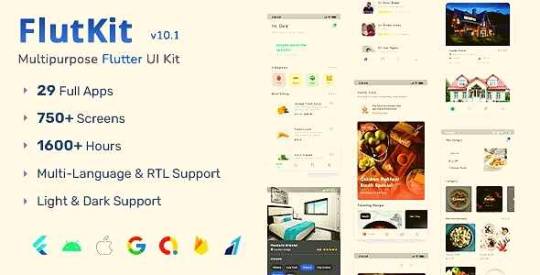
View On WordPress
0 notes
Text
What is Flutter and How to Use It for Cross-Platform App Development?
Flutter is a mobile application framework developed by Google that allows developers to build high-quality, cross-platform applications. With Flutter, developers can create beautiful user interfaces, add features easily, and launch apps quickly on Android and iOS platforms. Today, concerning this information will explore the basics of Flutter and examine how it can be used to create cross-platform applications.
What Is Flutter?
Flutter is an open-source mobile application framework created by Google that enables developers to build native Android & iOS apps with a single codebase. It is written in Dart, a language designed for fast development cycles and easy integration with other languages. The main advantages to Hire Flutter Developers are to increase the speed, flexibility, and wide range of features.
Using Flutter for Cross-Platform App Development
Flutter’s strength lies in its ability to develop cross-platform applications quickly and efficiently. Using the same codebase across multiple platforms saves developers time and resources while still creating high-quality apps.
Additionally, since Flutter has access to the underlying platform components such as sensors or Bluetooth APIs - users can add features like geolocation or integration with wearable devices without having to write separate code for each platform.
It makes developing apps for a variety of platforms much easier than before. Finally, Flutter reduces maintenance because there is only one codebase instead of two separate ones. All changes made to the codebase are reflected on all platforms in real-time, making it easier to track any changes or updates needed over time.
Benefits Of Using Flutter For App Development
Using Flutter for app development has many benefits, including quick development cycles, reduced costs associated with maintenance, access to more features due to platform integration support provided by the SDK (software development kit), improved user experience (UX) due to widgets that allow developers to create custom UI elements tailored specifically for their app’s needs, better performance due to its rendering engine which uses less memory than other solutions like React Native or Ionic Framework do.
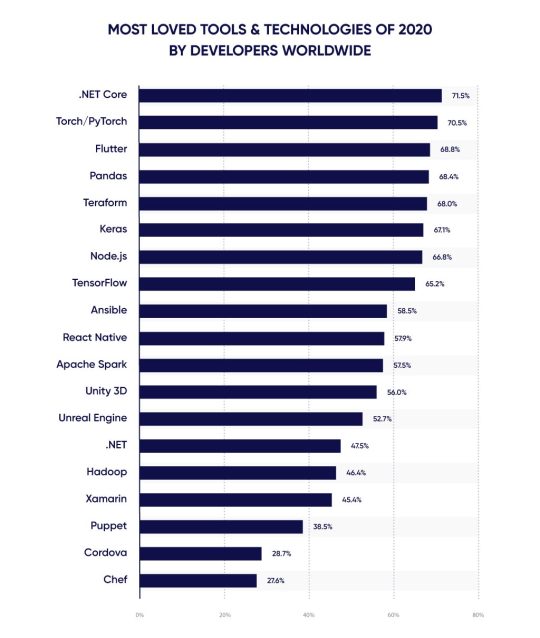
Source- https://light-it.net/blog/benefits-of-flutter-app-development/
As per the above stats, it is clearly shown how flutter become so popular in the web development market.
Additionally, Flutter helps ensure your app looks good on all devices regardless of screen size or operating system version since it doesn’t rely on device-specific components or libraries like other solutions. Finally, countless tutorials are available online, so you won’t have trouble finding help if you ever get stuck while developing your app.
Conclusion:
Overall, using Flutter for cross-platform app development can be extremely advantageous when done correctly, as it helps reduce costs associated with maintenance while still providing access to powerful features such as platform integration support provided by the SDK (software development kit).
Additionally, its rendering engine helps ensure better performance compared to other solutions like React Native or Ionic Framework while also allowing you greater control over user experience elements such as custom UI elements tailored specifically for your app’s needs through its widget library, which provides greater freedom when designing your user interface compared to other solutions offer too!
#hire flutter developers#marketing#freelancer#freelancing#flutter development#flutter app development#flutter application development#halogig#remote work
2 notes
·
View notes
Text
Why you should learn flutter in 2022?
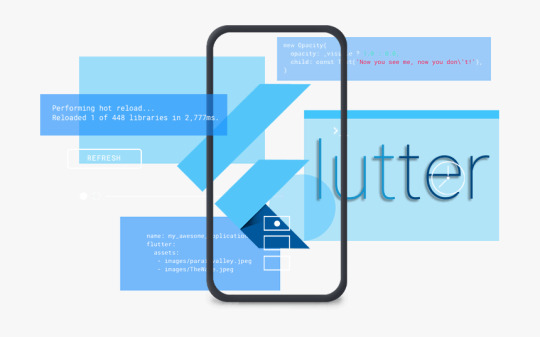
Before we go into why you should learn Flutter, there are a few things you should know about it. Google released it as an open-source cross-platform application development kit in May 2017. The ability to build programs for iOS, Android, the Web, and desktop is referred to as “cross-platform.” If you use Flutter, you won’t have to create and manage two different mobile apps for iOS and Android. This translates to decreased development costs. To get started on your project, you don’t require more than one developer. There will be no discernible difference between a Flutter and a native app. The widgets in Flutter may easily be customized to provide a user-friendly experience for your clients.
Even though native app development continues to reign supreme, cross-platform development has become the new standard. Furthermore, because cross-platform apps are easier to build and maintain, a growing number of medium-sized and small businesses are adopting cross-platform development. This means that the same code may be used to create Android and iOS apps. Flutter features a vast range of widgets and animation capabilities that may be utilized to construct almost any type of application. Flutter makes use of Dart, a programming language that is also a fundamental component of Flutter and is used to construct Android and iOS apps. Flutter is quicker and more efficient than React Native since it doesn’t need to connect with the platform via JavaScript.
Using some of the most popular cross-platform frameworks may potentially assist you in obtaining employment. Google’s Flutter, which was recently upgraded, is one of the most well-known cross-platform development frameworks.
Advantages of learning Flutter:
Faster Development: Flutter promotes quick development and saves developers a significant amount of time. You may simply build a distinctive UI/UX design for your apps by combining a range of enrichment widgets. Furthermore, Flutter makes it simple to integrate updates and immediately handle issues. Furthermore, testing and deployment of the app take less time when using Flutter. In comparison to its competitors, Flutter is a more efficient development platform.
To summarise, you don’t need to write platform-specific code to achieve the desired aesthetics for your program. Without the requirement for a native app comparable, Flutter may be used to create any 2D-based UI. Even though Flutter includes a declarative API for creating user interfaces, I’ve found that it boosts performance dramatically. This is the most obvious when it comes to making aesthetic changes.
Hot Reload: Flutter is getting more popular among smartphone developers because of its rapid reload feature. Hot reload allows code changes to be visible instantly on emulators, simulators, and real-world devices. It only takes a fraction of a second to reload the updated code. Because the program is already running, developers don’t have to waste time restarting it. As a result, creating UIs, adding new functionality, and fixing bugs are easier. Even if an issue happens, some programs may be patched and used as if nothing had happened. If a complete app refresh is required, it won’t take long, reducing development time.
Larger User Base: Imagine that if you have a programming problem, no one is around to assist you in figuring out what went wrong. What do you want to do as a developer? A Google or browser search for your error will turn up a similar problem with an acceptable solution. This is also when the Flutter community comes in handy! On QA sites like Stack Overflow, the Flutter developer community has developed dramatically in recent years.
Easier to Learn: Flutter is easier to learn than Java, and it’s a lot more useful if you already know Java. Additionally, you must be familiar with the Dart programming language because Flutter is written in it. Starting with the official documentation and video lectures is an excellent way to learn Flutter. It is advised, however, that you attend a course on the topic so that you are familiar with its operations from A to Z. It’s reasonable to predict that Flutter will soon dominate the mobile app development industry, which should answer your question about why Flutter is the best platform to learn on in the short term.
As more people transition to designing native apps, which Flutter is a fantastic solution for, the demand for Flutter developers is constantly increasing in the employment market. Even seasoned programmers with years of experience in the area are finding Flutter to be more user-friendly.
Why choose Baabtra’s Flutter Course?
The three-month Baabtra Flutter Course is built with one goal in mind: to ensure that anyone who completes it is well-equipped with all of the required skills to obtain a Flutter developer job right away. Flutter will allow you to construct native-looking Android and iOS apps. You’ll also learn how to solve a frequent job interview programming challenge as a bonus. This course will show you how to use Flutter to quickly create high-quality, interactive mobile apps for iOS and Android devices, as well as how to customize your app with rich and configurable widgets, built-in animations, and a layerable, extensible framework. Listed below are some of the most important reasons why thousands of students select Baabtra.
In a short period, you will learn how to design applications for a range of platforms.
Learn how to create iOS, Android, and other platform apps.
Learn how to use a single code base to create iOS and Android applications.
Acquire a thorough knowledge of Google Flutter’s core ideas.
Learn about one of the most rapidly evolving technologies and distinguish yourself from the crowd.
You will receive instant placement help after completing the course.
Flutter’s popularity is growing as more people use it to construct mobile apps. Flutter is outperformed by other cross-platform application development platforms. As a result, the community is seeing an increase in programmers. The Flutter community is likely to improve the framework, and it will eventually win the race. Flutter can supplant the current crop of native application development frameworks. The Flutter team has worked diligently in the years thereafter to improve and expand on the basic package it started with.
On Flutter, there are no limitations like there are on native platforms. It is possible to incorporate the native codebase. It does, however, need special code written by a developer in programming languages such as Java and C. By 2021, the flutter craze is expected to skyrocket in popularity. As stated in this piece, there are multiple reasons why Flutter is a huge deal in the cross-platform app development world. Flutter is a mobile app development framework that deserves to be at the top of the list.
Enquire now !!👇
https://bit.ly/3Igg4Z5
.
Follow us on:
Facebook: https://lnkd.in/gezVM78A
Instagram: https://lnkd.in/gWMMtQMe
LinkedIn: https://lnkd.in/gqZFN9rR
Twitter: https://lnkd.in/g_Dd5tKk
#flutter#app development#software#software developers#it#developers#mobile app development#coding#flutterdeveloper
2 notes
·
View notes
Text
What Are IOS Developer Programming Languages?
IOS programming languages are tools ios developers use to build applications for Apple's iOS platform within the Apple ecosystem including iPhones, iPads, iWatch, and Apple TVs.
Swift
Swift is a powerful and intuitive programming language created by Apple, specifically designed for ios developers developing iOS, macOS, watchOS, and tvOS applications. With an easy-to-read and write syntax, Swift has rapidly gained popularity among ios developers for building a wide range of applications. Swift code is safe by design and produces software that runs lightning-fast.
C#
C# is a cross-platform, object-oriented programming language developed by Microsoft in 2000. It runs on the .NET framework and is known for its simplicity and power. C# enables .NET developers to build a wide range of applications, from desktop to web to mobile, with a particular advantage in creating Windows applications.
React Native
React Native is a mobile app development framework that allows react native developers to create natively rendered apps for iOS & Android. Developed in 2015 by Facebook, React Native enables react native developers to leverage JavaScript and React libraries to build mobile applications.
Flutter
Flutter is an open-source UI software development kit created by Google. It's designed to craft natively compiled mobile, web, and desktop applications from a single codebase. This toolkit provides a new way for developers to build beautiful, fast apps for iOS and Android platforms without writing separate code for each.
Objective-C
Objective-C is an object-oriented programming language ios developers use to create applications for Apple's macOS, iOS, and iPad operating systems. It allows for creating applications that run seamlessly on Apple's platforms, providing a rich set of libraries and frameworks such as Cocoa and Cocoa Touch. It is easy to understand, and is known for its dynamic binding and reflection capabilities.
0 notes
Text
Unlock the Power of Flutter for Cross-Platform Development | Xicom
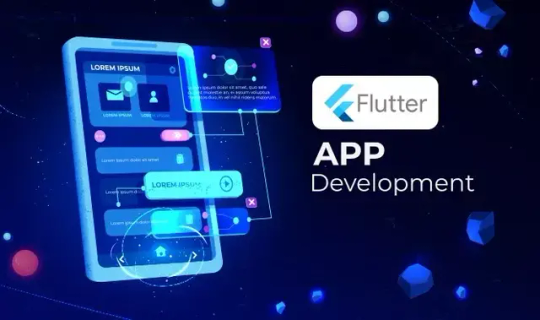
The rapid advancement of technology today has pushed the demand for faster, and better app development higher than ever. With businesses and developers aiming for a wider reach, multi-platform usage has become even more necessary. This is where the flutter technology is used. This amazing open-source framework, created by Google, has shattered the world of cross platform mobile app development with its unbeatable speed and ability to generate native-looking apps that can be run on different platforms. With the popularity of this technology, many Flutter app development companies are booming in the industry.
In this blog, we look into the Flutter world of cross-platform development and explore how it can help developers with making fast and cost-effective apps if they need to go multi-platform. Be it its system independence or feature packed nature, Flutter is a game-changer for cross-platform development. Thus, let us uncover the power of Flutter to understand why it is the preferred tool among developers the whole world over.
An Introduction to Flutter and Its Core Principles
Flutter stands as a beacon of innovation in the niche of cross-platform development, initiated by Google's foresight into simplifying the application development process. As an open-source UI software development kit, Flutter is meticulously designed to enable the crafting of visually appealing, natively compiled applications for mobile, web, and desktop from a singular, unified codebase. This revolutionary approach is grounded in Flutter's core principles which emphasize developer productivity, performance, and UI flexibility.
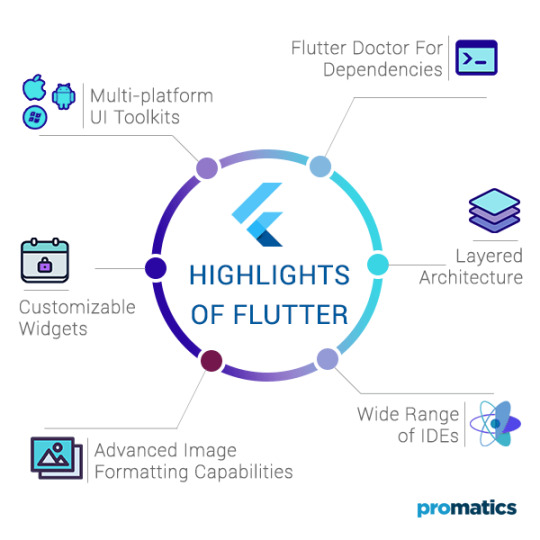
Flutter uses Dart, a programming language. Dart can turn into code that runs directly on devices. So it can easily talk to the device and run quickly. This helps Flutter apps start fast and run smoothly. Dart can do ahead-of-time and just-in-time code compiling. The hot reload feature lets developers quickly change code and see the results. Flutter believes beautiful, custom app designs should be easy to make. Its widget library helps developers build flexible, customizable user interfaces (UI). Flutter widgets work together, letting developers layer and combine them. This lets them create UIs that look natural on different devices and platforms.
Flutter has a layered design. This makes UI creation flexible and improves performance. Developers control exactly how each pixel appears on the screen. Flutter gives tools to make apps that look great and run smoothly on any platform. It creates high-quality cross-platform apps that seem native. Flutter provides efficiency and quality for app developers.
The Dart Programming Language: The Heart of Flutter
Google created Dart, an object-oriented programming language. Dart is fast because it turns code into machine instructions. This allows Flutter apps to run smoothly on iOS and Android. Dart uses ahead-of-time compilation. This makes Dart efficient at running code. A key part of Dart is its approach to handling tasks at the same time. Asynchronous programming keeps Flutter interfaces responsive. Dart also uses just-in-time compilation during development. This enables Flutter's hot reload feature. Hot reload lets developers see code changes instantly, without re-starting the app.
Dart requires variables to have defined data types. This catches errors and improves code quality. It makes Flutter apps reliable and easy to maintain. Dart's standard library provides many useful features. Its flexible syntax accommodates developers from diverse coding backgrounds. Flutter is useful because it allows developers to make apps for different devices. Dart makes this possible. Dart is the language that powers Flutter apps. With Dart and Flutter, developers can create cool, scalable apps that run smoothly on various platforms.
Flutter's Single Codebase: A Game-Changer for Developers
Using Flutter for cross-platform development is highly effective. This is due to its single codebase design. Developers no longer need separate apps for iOS and Android. They can focus on improving the app's core features and user experience. They don't need to maintain different codes for each platform.
Flutter's widget library and Dart's flexibility make this possible. Developers can build user interfaces that look and perform the same across devices. The single codebase approach covers the entire app logic too. This includes handling user inputs and managing the app's state. So, the app works seamlessly on any platform.
Using one codebase for multiple platforms is great. Developers can focus on testing one application better. This makes the product stronger and faster to build. Fewer tests are needed overall, which saves money. Flutter's single codebase approach really streamlines the process.
With Flutter's unified code-base, apps reach the market faster and perform better. This improved method advances cross-platform development. Flutter emerges as the go-to toolkit for innovative developers seeking efficiency without compromise.
Widgets: The Building Blocks of Flutter Apps
Flutter's creative UI design centers on its widget library. These are customizable UI parts like text boxes, buttons, grids, and tabs. Developers use them to construct any user interface. Widgets can contain other widgets for complex designs. This flexibility enables intricate, dynamic UIs that other cross-platform tools can't match.
What's unique about Flutter widgets? Not just how adaptable and varied they are. But also how they need to be within each other hierarchically. Developers stack widgets to architect sophisticated UIs freely. This compositional power showcases Flutter's expressive capability. With Flutter, your visions aren't limited by traditional frameworks.
Flutter uses widgets to build apps. Widgets are special parts that make apps look nice and work well. Each widget helps apps update their looks smoothly and quickly. This is important for apps that change a lot on the screen.
There are many widgets to choose from. Developers make new widgets too, which makes Flutter even better. When developers share widgets, it helps everyone build apps faster. Fun new ideas can spread, so apps look cool and work great. Flutter's widgets let developers build apps that look beautiful and run smoothly. This makes Flutter a top choice for making apps that work on many devices.
Flutter's Speed: A Superpower
Flutter makes apps that run super fast, almost like apps made just for one device. It does this using a coding language called Dart. Dart turns code into instructions devices can understand directly. This makes Flutter apps really efficient without slowing down. Other app tools can be slower because they need extra steps to talk to devices.
Flutter has a special way to draw things on the screen. It does not use the phone to draw parts of the app. Instead, Flutter draws every part of the app itself. This lets Flutter make cool, moving designs. It also makes Flutter apps smoother and faster. Animations and transitions are very smooth in Flutter apps.
Flutter apps are built with widgets. Widgets do not change. But they are rebuilt when something in the app changes. This way, Flutter apps stay fast. They do not slow down, even with lots of changes. Flutter also uses computer memory well. This helps keep apps quick.
Because of these smart tricks, Flutter apps can be as fast as apps made just for one type of phone. Developers can make apps that work great and run smoothly. So Flutter is a good choice for making fast apps that work on many devices.
The Flutter Ecosystem: A World of Plugins and Packages
Flutter has many plugins and packages that developers can use. These add new abilities to apps. Some plugins do small, simple things. Others connect to the phone's hardware like GPS or camera. The Flutter community is always making more plugins. Both Google and independent developers make them. So when developers need a feature, there is probably already a plugin for it. This helps developers make great apps quickly and easily.
The Flutter ecosystem does more than just improve device interactions. It also includes packages for managing app states, making network requests, caching data, and other important modern app development tasks. The packages speed up development by allowing developers to focus on creating unique user experiences instead of reinventing the wheel for common features. As Flutter becomes more popular, its ecosystem grows more diverse and capable, making it a strong framework for tackling modern app development challenges.
Real-World Applications of Flutter
Leading global companies use Flutter's robust framework, showcasing its adaptability and skill in cross-platform development. For example, Google uses Flutter to deliver consistent user interfaces in its Ads platform, boosting productivity and efficiency. Alibaba, one of the world's largest e-commerce companies, uses Flutter for parts of its Xianyu mobile app, achieving seamless cross-platform performance for millions of daily users. Tencent, a major tech company, uses Flutter to create engaging user experiences for its popular AITeacher app, demonstrating Flutter's ability to handle dynamic content and interactive features effectively.
Beyond big companies, startups and medium-sized businesses also use Flutter, showing its versatility and scalability. Flutter powers innovative health tech apps focused on patient care, dynamic sports analytics platforms, and more. Its ability to deliver native-like performance, combined with the rich Flutter ecosystem, allows developers to easily incorporate complex features like real-time data analytics, AI-driven recommendations, and immersive AR/VR experiences. These real-world applications show Flutter's transformative impact on the digital landscape, confirming its position as a go-to framework for developers building high-quality, cross-platform solutions that meet a wide range of industry needs.
Flutter for Web and Desktop: Beyond Mobile
Flutter was made for mobile apps first. But now it can also make web and desktop apps. Google made Flutter able to do this. It means developers can use the same code for mobile, web, and desktop apps. The look and feel of the app will be the same across all devices. Developers don't need to write separate code for each platform anymore. This makes development faster and easier. Flutter lets developers create apps for multiple devices without extra work. It is an efficient way to make apps that work everywhere.
Conclusion
Flutter is changing how apps are made. With its single codebase approach using Dart, Flutter simplifies app development that’s why it’s widely used by Flutter Development Companies across the globe. Apps made with Flutter look and perform like native apps. Flutter has many widgets and runs smoothly. It is useful for many types of apps, like e-commerce and startup apps. Now that Flutter works on the web and desktop too, it can create digital experiences across all platforms. Developers only need to use Flutter to make apps for any device. Flutter keeps improving with help from its community. It is a great choice for efficient cross-platform app development.
#Flutter app development companies#Flutter Development Company#Flutter App Development Company#Flutter Development Companies#Flutter app development company in USA#top Flutter app development company#top Flutter app development#xicom#xicom technologies
0 notes
Text
Our Expertise in Mobile App Development
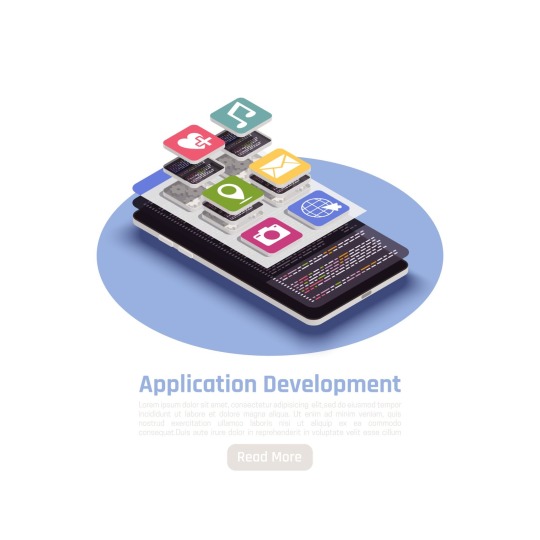
We design and develop software applications of diverse types and complexities spanning across industries. From cloud-based and embedded apps to apps built for the web, mobile devices and desktops, we develop a range of software applications matching your needs, industry best practices and market standards.
Create a Competitive Edge with our Custom App Development Services
Our team of expert developers applies leading-edge technologies to design and build applications that seamlessly align with your brand, vision, and target audience. We ensure client satisfaction by collaborating with them to comprehensively understand their unique business needs before starting their project. Whether you want to increase productivity, streamline operations or enhance the user experience for your customers, our custom applications help you achieve your goals.
OUR APP DEVELOPMENT SERVICES
Android App Development
Our Android app developers are skilled at creating dependable, scalable Android solutions. As an app development companies, we develop unique Android apps that exhibit superior-level performance, ensuring scalability.
iOS App Development
We comprehend the high standards required for an iPhone app. Leveraging our extensive knowledge and experience in modern iOS app development technologies, we deliver robust iOS app that meet user performance expectations.
Website App Development
We develop web applications that enable streamlined software to function within a web browser. Our experienced developers use the latest technologies and frameworks to create fast, secure, and easy-to-use web applications.
Flutter App Development
Being up-to-date with this open-source UI software development kit and making the most of extensive expertise in Flutter and its innovative app development approach, we are a team of top Flutter app developers , which clients trust.
UI/UX Design
We create your app’s UI/UX design, emphasizing its visual appeal and functionalities. Wireframes and prototypes are built to ensure the application is user-friendly and intuitive and offers an excellent user interface experience.
Support and Maintenance
Our app development services also include ongoing maintenance and support services, which include frequent software updates, bug fixes, and performance improvement, which ensures enhanced functionality, security, and user experience.
Eminence Rise Media: Your One-Stop Mobile App Development Services Company
GET IN TOUCH WITH US TODAY!
(201) 281-9651
Transforming Your Innovative Ideas Into Reality
0 notes
Text
Importance of Flutter for Future Mobile App Development
When you want to develop a mobile app that works on multiple platforms, the first thing that comes to mind is what framework or development kit you should use. The best way to do this is with the Google Flutter application development framework. There are many things to think about when choosing which technology to use to build your app. Fortunately, the Google Flutter development framework provides a quick and easy solution for your application development needs.

What is Flutter Development?
Flutter is an open-source front-end framework that creates cross-platform, high-quality mobile apps. Flutter is a cross-platform, open-source mobile application development framework. It enables developers to build high-quality, fast-loading, and responsive applications for both iOS and Android devices.
It enables you to build mobile apps using HTML5 and CSS3, as well as Javascript. The goal of Flutter is to make mobile app development easier and more productive than other frameworks by using a single language that works on all platforms instead of using several languages for each platform.
Features of Flutter Development
Flutter is one of the most popular cross-platform development frameworks. It is different from other frameworks for a few reasons. Here is a detailed explanation of what makes Flutter a great framework for building feature-driven mobile apps.
Hot Reload
Single CodeBase
High Performance
Expressive UI
Access to Native Features
Consistent Design Across Platform
Web and Desktop Support
Open Source and Backed by Google
Future of Flutter For Mobile App Development
Flutter is a Google mobile app SDK that allows you to create native applications for both Android and iOS. Flutter leverages the power of Dart to provide a seamless, fast, and optimized mobile experience.
The future of Flutter development looks promising for mobile app development. This framework is in its infancy and still has a long way to go. It is free, open-source, and Google-developed, so there will be a lot of support out there.
In addition, the Flutter team is actively developing new features, so expect to see even more enhancements in the future. For instance, Flutter supports native vector graphics and animations. This means that developers can easily build complex UI designs without needing to rely on external libraries or frameworks.
Conclusion
The use of Flutter in app development has enabled developers to create cross-platform apps using the same framework, something that has never been possible before. One of the main benefits of using Flutter is that it allows developers to create highly interactive applications. This means that developers can create rich user experiences in a matter of minutes, rather than days or weeks. Flutter offers a powerful way to write applications that can be tested on multiple devices without having to worry about writing different native code for each platform.
Are you looking to create the next big app?
CRM Master’s Infotech is a Flutter app development company that specializes in Flutter. We have a team of experienced mobile app developers who have successfully developed apps for startups and businesses.
Source: https://crm-masters.com/importance-of-flutter-for-future-mobile-app-development/
0 notes
Text
What is Flutter and Why 2024 Is the Perfect Time to Learn It?

Mobile applications have become more and more common this year. Fortunately, developers who wish to make them have access to a wide variety of programming tools. Flutter is one of these tools that has been making waves lately.
Flutter: What is it?
Google announced Flutter, a free and open-source mobile user interface framework, in May 2017. To put it briefly, it lets you use a single codebase to generate native mobile applications. This implies that you can create two distinct apps (for iOS and Android) using the same programming language and codebase.
Flutter is made up of two key components:
A set of tools called an SDK (Software Development Kit) will assist you in creating applications. Included in this are resources for converting your code into native machine code (iOS and Android code).
A Framework (UI Library based on widgets) is an assortment of reusable user interface components (such as text input fields, sliders, buttons, and so forth) that you can customize to suit your requirements.
You will use the programming language Dart to work using Flutter. Although Google invented the language in October 2011, it has seen significant improvement in the intervening years.
Dart is a front-end programming toolkit that may be used to create web and mobile applications.
Dart is a typed object programming language, for those who know a little bit about programming. The syntax of Dart is similar to that of JavaScript.
Google's UI toolkit, Flutter, allows developers to create stunning natively built desktop, web, and mobile applications from a single codebase. Search engine, flutter.dev
Why would you want to learn Flutter?
I've chosen a few of my favorite Flutter features and the reasons I plan to use it in the upcoming year. Details and my thoughts are provided below.
Easy to use and understand
You can sense that Flutter is a contemporary framework! Using it to construct mobile applications is much easier. You will note that Flutter differs from Java, Swift, and React Native if you have used any of these. Before utilizing Flutter, I had little interest in developing mobile applications.
I adore Flutter because it makes it possible to construct a truly native application without writing a ton of code.
Fast compilation for optimal output
You can alter your code and witness the real-time consequences because of Flutter. It's known as Hot-Reload. Once you save, updating the application itself just takes a little while. You must reload the application if there are significant changes. However, when working on projects like design, for instance, you can alter an element's size instantly!
Suitable for MVP launches
Flutter is an excellent option if you want to present your idea to investors as soon as feasible.
My top 4 arguments for using it for your MVP are as follows:
Since you don't have to make and manage two mobile apps—one for iOS and one for Android—developing a mobile application with Flutter is less expensive.
To design your MVP, all you need is one developer.
You won't be able to tell a Flutter app from a native application because of its performance.
t's gorgeous; you can quickly customize it with the widgets offered by Flutter to produce a useful user interface for your clients
VS Code and Android Studio-compatible,
Flutter is accessible through a variety of IDEs. For development with this technology, VS Code and Android Studio (IntelliJ) are the two primary code editors.
Android Studio is a fully functional software that comes with everything pre-integrated. To get started, you must download the Flutter and Dart plugins.
VS Code is a little application with configurable features thanks to third-party plugins.
I use Android Studio since it requires minimal configuration to function.
You can select the IDE of your choice!
Are you attempting to create a fully functioning cross-platform application that provides an enjoyable user experience? Now there's another place to search! As a reputable Flutter app development firm, we have developed feature-rich apps for companies and startups worldwide. The skilled Flutter app developers at Mobantica are dedicated to bringing your idea to life and offering the best possible mobile app solutions. Hire Flutter developer to validate your business idea, and get in contact with us right now.
Conclusion:
So, what are your thoughts on Flutter? Next year, are you going to begin studying it?
I hope you were intrigued and inspired by this introduction. If you enjoyed this post, please consider sharing it.
You may follow me on Twitter, where I tweet about web development, personal growth, and my path as a full-stack developer if you want to see more posts like this one!
0 notes
Text
Why Choose Flutter Development Services for Your Startup?
In the fast-paced world of technology, startups are constantly seeking innovative solutions to stand out in the market. With the rise of mobile applications as a primary means of reaching consumers, choosing the right development framework becomes crucial for startups looking to develop robust, efficient, and visually appealing apps. Flutter, Google's open-source UI software development kit, has emerged as a popular choice among startups for its versatility and efficiency. In this article, we'll explore why Flutter development services could be the ideal choice for your startup.
Cross-Platform Development: One of the most significant advantages of Flutter is its ability to create apps for multiple platforms using a single codebase. This means that startups can develop applications for both iOS and Android simultaneously, saving time and resources. With Flutter, developers can write code once and deploy it across different platforms, ensuring consistent performance and user experience across devices.
Faster Development Time: Startups operate in a highly competitive environment where speed is often the key to success. Flutter offers a hot reload feature that allows developers to instantly see the changes they make to the code, resulting in faster development cycles. This rapid iteration process enables startups to bring their products to market quicker, giving them a competitive edge.
Beautiful and Customizable UI: In today's digital age, users expect visually stunning and intuitive interfaces. Flutter provides a rich set of customizable widgets and tools that allow developers to create beautiful UI designs that align with their brand identity. Whether it's implementing custom animations or designing complex layouts, Flutter empowers startups to deliver engaging user experiences that resonate with their target audience.
High Performance: Performance is a critical factor in the success of mobile applications. Flutter's architecture is optimized for high performance, enabling smooth animations and responsive interfaces even on less powerful devices. By leveraging Flutter's performance capabilities, startups can ensure that their apps deliver exceptional performance, resulting in higher user satisfaction and retention rates.
Cost-Effectiveness: For startups operating on limited budgets, cost-effectiveness is paramount. Flutter's cross-platform development approach significantly reduces development costs by eliminating the need to maintain separate codebases for iOS and Android. Additionally, the faster development time associated with Flutter translates to lower labor costs, making it an economical choice for startups looking to maximize their ROI.
Growing Community and Support: Flutter boasts a vibrant and rapidly growing community of developers, enthusiasts, and contributors. This active community provides extensive support, resources, and third-party packages that further streamline the development process for startups. With Flutter, startups can tap into this vast knowledge base to overcome challenges, troubleshoot issues, and continuously improve their applications.
Future-Proof Technology: As technology evolves, startups need to adapt and embrace emerging trends to stay relevant. Flutter is backed by Google, ensuring ongoing support, updates, and enhancements that keep pace with the evolving needs of the industry. By choosing Flutter for their development needs, startups can future-proof their applications and position themselves for long-term success.
In conclusion, Flutter development services offer a myriad of benefits for startups looking to build cutting-edge mobile applications. From cross-platform compatibility and faster development time to stunning UI designs and high performance, Flutter empowers startups to create compelling user experiences that drive business growth. By leveraging Flutter's capabilities, startups can streamline their development process, reduce costs, and gain a competitive advantage in the crowded app market. If you're a startup looking to elevate your mobile app strategy, Flutter may be the perfect choice for turning your vision into reality.
0 notes
Text
How to Hire Flutter App Developers for Your Next Project?

In the modern day, Mobile applications have become an integral part of daily life, making everything simple. Many entrepreneurs and startups have been seeking a better way to leverage mobile applications to reach more customers. These are also helpful for gaining a better competitive edge to the extent.
Flutter is an open-source app development framework used by several developers. Flutter gained popularity among businesses to create cross-platform capabilities.
Whether you are looking for cost-effective and fast development then you need to Flutter developers in the USA. Developing a successful mobile app involves the right team of developers.
Why is Flutter development so popular?
Flutter is the open-source UI software development established by Google, and many developers prefer mobile app development. The Software Development Kit involves the best collection of reusable UI elements such as text inputs, sliders, buttons, and more.
The SDK channel collection is perfect for mobile app development as well as helps for compiling the codes for Android or iOS. Flutter is also quite easy to learn as it involves clear syntax.
Flutter programs are super fast compared to JavaScript programs. Normally, Dart can easily compile the codes JIT (Just In Time) and AOT (Ahead Of Time).
How to hire Flutter app developers?
Hiring the right Flutter developer will be completely essential for ensuring the application meets specific requirements. Evaluating the developer’s experience, communication, and skill set is essential. Follow the below steps to easily hire the Flutter app developers.
1. Understand the developer’s role in Flutter app development:
The role of a mobile app developer is to understand application requirements for designing and writing the codes. Having a thorough understanding of Flutter’s framework also helps to enhance the ability to develop cross-platform mobile apps.
2. Compose job description:
Hiring new specialists with the best knowledge and experience in Flutter ASAP is a more convenient option. You need to compose a clear job description that lets you post on the Job boards. It is quite convenient for structuring ideas based on the demands, responsibilities, and requirements.
Some of the essential job description writing elements are listed below:
Job brief
Requirements
Role and its responsibilities
Bonuses and benefits of the job
3. Budget allocation:
Completely determining the requirements will be a great option for allocating the budget range. Normally, the budget is the crucial factor for the app development project.
Many companies do not keep the budget for developing the app. It is quite advisable to completely keep a flexible budget range.
Understand that the quality of a product comes with a price, so it is essential to set the budget for the project accordingly. Make the initial budget upon completely considering the general app development cost. Consult requirements with an expert so you can simply set the budget.
4. Evaluate the experience and skill set of the developer:
Normally, evaluating the developer’s experience as well as skill set is essential. You can simply ask for experience working with the Flutter framework along with developing mobile apps. Consider the experience with programming languages such as Java, Dart, Kotlin, or others.
5. Check the portfolio and past projects of developers:
You need to thoroughly review the developer’s portfolio as well as past projects. These would provide you with complete insight into the work quality, development style, and more. Ensure that they have worked on similar projects in the past.
6. Assess communication and collaboration skills:
Designing and developing the mobile app requires a collaborative process. You need to ensure assessing the proper communication and collaboration skills of the developer.
It is also important to consider the ability to provide regular progress updates or even work in a team. You need to ensure that they meet the deadline appropriately.
Recruiting the Flutter mobile app developers who are responsive, proactive and also communicate with non-technical stakeholders is important. Experienced and skilled Flutter developers could easily adapt to working collaboratively with the clients is essential. They need to meet the specific requirements of clients.
7. Interview the developers:
Upon shortlisting the Flutter app developer based on experience, skill set, communication skills, and portfolio, you need to conduct interviews. Filtering the candidate is easier through the interviewing process.
It is important to ask the:
Technical questions
Expertise
Experience working with clients
Knowledge of emerging technologies
Soft skills
How they meet tight deadlines
How they tackle a particular problem
Creativity they can bring to the table
Communication skills
8. Payment structure:
Upon completing the interview, it is easier to filter the team of Flutter app developers. You need to discuss the payment structure along with a partnered offshore app development team. Normally, app development companies would follow a set of payment structures.
You would be making the payments after the milestone is achieved for development. Ensure that Flutter mobile app developers are mentioned in the contract.
9. Signing contracts and paperwork:
You can sign the contracts for processing the paperwork with the Flutter custom mobile app development company. This helps you to simply start the Flutter app development with the legal contract.
Some of the lists of contracts that you need to sign for hiring Flutter app developers are:
Master Services Agreement (MSA) – Main contract with general terms and conditions
Intellectual property agreement – Intellectual Property Agreement protects ownership of app’s intellectual property
Non-Disclosure agreement – Confidentiality agreement
Support and maintenance agreement – Details related to support and maintenance after the launch of the app
Quality assurance and testing agreement – Defines testing and quality assurance processes
Payment and invoicing agreement – Outlines payment structure

Conclusion:
Establish a reporting structure after signing contracts and it helps get regular updates regarding the app development project. Following the steps lets you simply hire Flutter mobile app developers. The process is essential for hiring top-notch Flutter developers. Contact us for more details.
0 notes